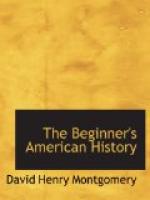88. Philip becomes chief; why he hated the white men; how the white men had got possession of the Indian lands.—Philip now became chief. He called himself “King Philip.” His palace was a wigwam made of bark. On great occasions he wore a bright red blanket and a kind of crown made of a broad belt ornamented with shells. King Philip hated the white people because, in the first place, he believed that they had murdered his brother; and next, because he saw that they were growing stronger in numbers every year, while the Indians were becoming weaker.
[Illustration: THE BELT WHICH KING PHILIP WORE FOR A CROWN.]
When the Pilgrims landed at Plymouth, Massasoit, Philip’s father, held all the country from Cape Cod back to the eastern shores of Narragansett Bay; that is, a strip about thirty miles wide. The white settlers bought a small piece of this land. After a while they bought more, and so they kept on until in about fifty years they got nearly all of what Massasoit’s tribe had once owned. The Indians had nothing left but two little necks of land, which were nearly surrounded by the waters of Narragansett Bay. Here they felt that they were shut up almost like prisoners, and that the white men watched everything that they did.
89. How King Philip felt; signs of the coming war; the “Praying Indians”; the murder.—King Philip was a very proud man—quite as proud, in fact, as the king of England. He could not bear to see his people losing power. He said to himself, if the Indians do not rise and drive out the white men, then the white men will certainly drive out the Indians. Most of the Indians now had guns, and could use them quite as well as the whites could; so Philip thought that it was best to fight.
The settlers felt that the war was coming. Some of them fancied that they saw the figure of an Indian bow in the clouds. Others said that they heard sounds like guns fired off in the air, and horsemen riding furiously up and down in the sky, as if getting ready for battle.
But though many Indians now hated the white settlers, this was not true of all. A minister, named John Eliot, had persuaded some of the red men near Boston to give up their religion, and to try to live like the white people. These were called “Praying Indians.” One of them who knew King Philip well told the settlers that Philip’s warriors were grinding their hatchets sharp for war. Soon after, this “Praying Indian” was found murdered. The white people accused three of Philip’s men of having killed him. They were tried, found guilty, and hanged.
90. Beginning of the war at Swansea;[3] burning of Brookfield.—Then Philip’s warriors began the war in the summer of 1675. Some white settlers were going home from church in the town of Swansea, Massachusetts; they had been to pray that there might be no fighting. As they walked along, talking together, two guns were fired out of the bushes. One of the white men fell dead in the road, and another was badly hurt.




